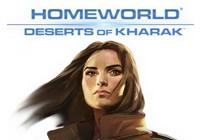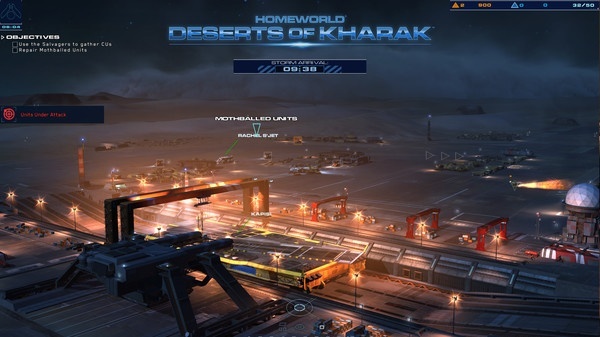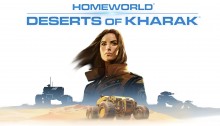Homeworld: Deserts of Kharak (PC) Review
By Athanasios  27.03.2016
27.03.2016

Besides being great, the first two Homeworld titles were the first in the realm of RTS that offered full three-dimensional movement, since the action took place in space. Gearbox Software, the current holder of this IP, however, chose to land on the surface of a barren planet, with Homeworld: Deserts of Kharak exploring the series' mythos right where it all began. Will the shift in location alter the fun factor, or does this actually improve the formula?
The planet of Kharak is slowly dying, with most of its surface being covered by sand dunes. It's in this world that Coalition scientist, Rachel S' Jet, must aid her fleet reach a certain anomaly deep inside the scorching desert, and use it to tip the scales to their advantage… unless stopped by the Kiith Gaalsien, the nomadic, religious fanatics of this world. Does "Rachel S' Jet" ring a bell? Well, that's only because she is the ancestor of an important character from Homeworld, since this is actually the story of how the people of Kharak found a way to step into the Final Frontier.
The good? There's no need to have played the previous two episodes to enjoy this one. The bad? It's all very, very boring. Besides characters who sound disinterested in their own ordeals due to their deadpan voice-acting, and other than the fact that this mission is just a simple long "walk" broken into several chapters, the plot is not handled that well. For starters, it's never explained how this, almost MacGuffin-like, "anomaly" will be of any use. Furthermore, no one ever develops at all. Rachel S' Jet is just the protagonist, the Gaalsien are the ones standing between her and her supposed salvation, and that is it.

Generally, Homeworld: Deserts of Kharak lacks character, with a generic ambient score full of middle-eastern elements, and two factions that look exactly the same, with the only difference being that the Gaalsien fleet uses hover technology instead of wheels. Fortunately, and while the blandness of the desert might become boring too soon, everything looks great, managing to capture the mood of that particular type of landscape, the same way the Homeworld series has managed to do the same with the equally empty space.
The real problem of the campaign, though, is its almost tutorial-like level of handholding, with each stage offering a tiny amount of new "toys" to play with, and with most - if not all - objectives being so clear that nothing every really feels challenging; the intelligence officer "suggests" the creation of some AA-turrets "here" or the use of a unit's ability "there," the order is carried out, and all ends up fine. Finally, this will only last for about eight hours, and since it's possible to start each mission with units created in the previous one, genre veterans might even reach the finish line much faster.

What about the gameplay as a whole, however? Does it shine in the Skirmish/Multiplayer portion? While generally a standard RTS, the action revolves around a mobile base (in this case a Command Carrier instead of a spacefaring Mothership). This versatile type of headquarters is the place where units are built, where upgrades are chosen, and where aircrafts can take off and return to after doing their thing. Furthermore, by retrieving scattered - and rare - artefacts, the Carrier can upgrade/downgrade various systems on the fly, like better offensive/defensive capabilities, as well as the capacity for self-repair.
The only problem with this mammoth of a unit is that it can't really move everywhere, especially since the desert is full of high hills and narrow paths, which means that the one doing all the thinking must carefully plan when to send "who" away from the base to gather resources, many times leaving behind a much smaller force to defend the Carrier. What about the change in location, though? Does it ruin what the series is all about? Luckily, while there's no "true" Z-axis here, awareness of altitude and line-of-sight is imperative, with units on higher ground being far more lethal.

Unfortunately, the actual gameplay leaves a lot to be desired. For starters, even those usually searching for the 'slowdown' key will find this to be a bit too slow to their liking. Sure, not every RTS should be fast-paced like StarCraft, but this can be so slow at times that it all feels like a TBS such as Civilization; forbidden for multiplayer matches. Also, for a game whose scale is so massive, the zoom-out distance is pretty lame, which translates to having to spend most of the time in the satellite view, called Sensor Manager, which, like with Supreme Commander, makes it easy to see everything, yet harder to micromanage units.
The problems continue with the lacklustre enemy AI, which will initially give the illusion of challenge, since it cheats and starts building procedure faster and bombards the opponent's base with wave after wave of units, but #1: this strategy is extremely predictable, and #2: the CPU can do the stupidest of things at times, like not even bothering to defend itself. Homeworld: Deserts of Kharak's biggest flaw, however, is that it feels incomplete. On top of the annoying lack of certain options (like the grave sin of not being able to change controls), there's not really much to do here. A small campaign, a disappointing amount of skirmish maps, only two - unbalanced - factions with little to no differences, and that's it.

Cubed3 Rating
Average
Why exactly did Homeworld: Deserts of Kharak get so many favourable reviews? Sure, it has some interesting mechanics, like the mobile base, and, yes, it's not horrible, but it feels incomplete and… bland. The campaign is easy and short, the skirmish mode doesn't give enough things to experiment and try different strategies with, its two factions are almost identical, and the AI is quite stupid, to say the least. Want a good Homeworld game? Try out the previous two in the series.

![]() 5/10
5/10
![]() 0
(0 Votes)
0
(0 Votes)
 Out now
Out now  Out now
Out now  None
None  Out now
Out now Comments
Comments are currently disabled

 Sign In
Sign In Game Details
Game Details Subscribe to this topic
Subscribe to this topic Features
Features






 Top
Top

